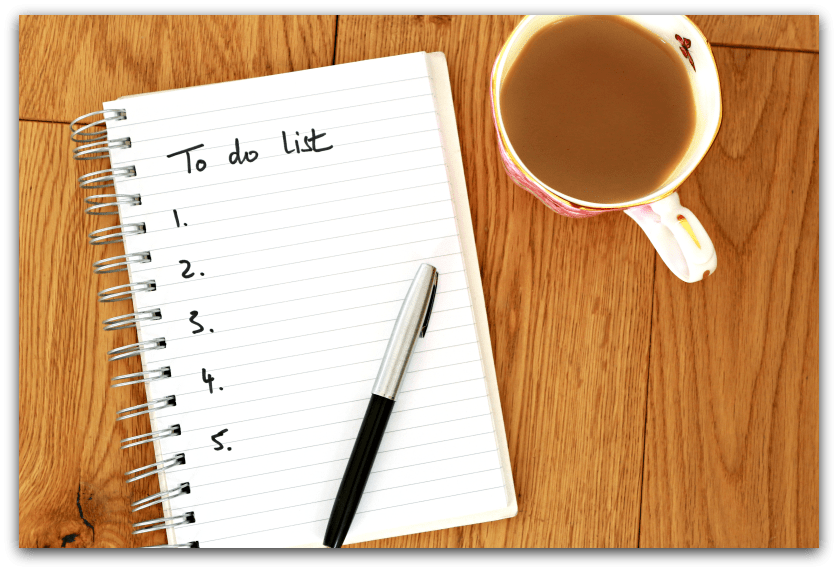9 Secrets to Boost Your To Do List Productivity
9 Secrets to Boost Your To Do List Productivity
How many times have you written a to do list, only to leave it lying around on your desk, or stuck to your fridge as an annoying reminder of all the many things you need to get done? Then to find that even though you cross off one or two items, the original list is so long, that you need to write yet another list, and neither of them have yet been finished?
I’m still guilty of doing this, but making a few tweeks to how I use my lists, I’m finding that I achieve the majority of to do’s I need to do.
Why are to do lists so important to our success?
Time is a limited resource. Once it’s gone, its’s gone and there’s no getting it back. So it’s vital that we use our time wisely. To do lists enable us to plan out in detail what it is we need to do in order to achieve our goals.
Time is a limited resource. Once it's gone, there's no getting it back. Use your time wisely. Click To TweetTo do lists create a concrete framework
Sometimes I think about all the things I need to get done and could very easily go into panic mode as my brain chaotically skims from one fragmented thought to another. I end up feeling overwhelmed and seriously daunted about how I am going to achieve it all.
A to do list helps to combat the feeling of overwhelm. It also helps to clarify the various stages of a task that need completing in order to achieve the end goal.
When I write the to do list, I am taking away the emotion that would keep me held hostage in panic-mode. The to do list gives me a framework that I can work through methodically and logically. Sure, there will be extra tasks that get added as something comes up that I may have overlooked when I first wrote the list. So long as I have a framework to follow, I am able to see my achievements and get a sense of satisfaction from what I have crossed off already. And a sense of confidence that I just need to keep plugging away at the various tasks to succeed.
Prioritize
When I have listed everything it’s important then to prioritize what needs to be done first. This is an important step and has transformed how I tackle my to do lists. A few years ago I would write a list and then cherry pick the tasks that I either enjoyed doing or were easy to complete. However, this meant I became really good at ignoring the most important tasks which were generally the ones which made me feel uncomfortable.
That was until I read the book “Eat That Frog!” by Brian Tracy. Essentially he says that by achieving the task you least want to do first, it frees up mental energy to focus on the tasks further down the list. You get a huge sense of satisfaction by getting rid of the worst task first, and the rest of the tasks don’t seem quite so scary or onerous.
Make your goals specific
When we write a to do list, it’s important to know what our specific goals are that we want to achieve. If you work in a group environment, goals enable each individual to work within their own strengths while pursuing a goal common to the group. It is really motivating to edge closer to the goal and helps to keep the team on track and focused. It also lets you know when you’ve got there so that you can embark on some serious celebrating.
Remember that goals can and do change as time goes on. Flexibility in the planning and creation process are key. Also regularly check your progress so you know you are on the right track.
Make your goals achievable
A useful tip which I learnt from reading Tim Ferriss’s “The 4-Hour Work Week” is to make goals easy to achieve. Instead of feeling daunted by the complexity of achieving certain goals, lower the bar of what you expect of yourself. This way you are constantly boulstering your confidence in your ability to meet your goals. You create a safe environment to continue to meet future demands and commitments. And as your confidence grows, so does your ability to take on more difficult and daunting tasks with ease.
He also mentions that our to do lists are too long. He says to focus only on one or two to dos for the day. Hone your focussing skills and stay on task. And it is highly likely you will achieve those to dos. Then there is nothing to stop you embarking on the next to dos thereafter. You will get a huge sense of satisfaction and confidence in your ability to work through your commitments in a laser-focused and time-efficient manner. At the end of each working week, schedule half an hour to review your goals and check your progression.
Balance your to do list with a done list
We all need balance in our lives, so do our to do lists. Sometimes when I have a long to do list, I actually write a few things down on it that I’ve already done that day. Doing this helps to motivate me to do more. It shows me that I’m getting through the list, even though, technically I’ve just added extra to dos to my list. It is soul-destroying to be faced with a list that looks as though it will take you until eternity and beyond to strike everything through. Having a few to dos already crossed off shows that you are getting results. Results make you feel good. They boost your motivation and generally make the challenge of achieving more to dos more enjoyable.
The Zeigarnik effect
Thanks to the observations and studies of Bluma Zeigarnik, a Lithuanian-born psychologist, we have evidence that when we leave tasks unfinished, we drain our brain. In essence we waste energy on ruminating about a task that still needs completion. When we complete a task, we get a sense of satisfaction. When we leave a task undone, we get a nagging anxiety that niggles away at us and ultimately steals some of the focus we should be using on the next task.
The Pomodoro Technique
The Pomodoro Technique is a time-management tool which helps to break down tasks into bite-size chunks. You work for 25 focused minutes on a single task then take a 5 minute break. After 4 periods of 25 minutes you take a longer break. For procrastinators, this is an easy way to help ease you into the flow of a larger project. Once I’m up and running, I tend to keep on going, however, it’s a useful tool to ensure I start off productively. Sometimes when faced with a tricky task, I drift off into the realms of social media doing just about anything else other than the task I need to get done. The Pomodoro Technique obliges me to face the fear and get on with it.
The Pavlok
If you need a bit more of a kick in the proverbial to get you started on a task, you need to invest in a tool called the Pavlok. I have just recently discovered it via Pat Flynn’s SPI podcast 216 where he interviews Maneesh Sethi, the creator of Pavlok. Pavlok is a tool you wear on your wrist which delivers a mild electric zap when you deviate from the task you have set yourself. In fact, not only does Pavlok help you stay on task, it helps you to kick bad habits and develop new good habits. Essentially it enables your brain to create an aversion to the bad habit when you sense the zap stimulus. If self-discipline is a problem for you, let Pavlok help you achieve your goals.
Take it outside
Sometimes we need more than a cup of coffee as a break. I’m a nature lover and love nothing more than being outdoors. So much so that I invested in an iCap laptop tent a couple of years ago and use it whenever the weather permits. Time in nature boosts your immune system, fills your lungs with fresh air and re-energizes your body and mind. If outdoors isn’t your thing, find a coffee shop or other public place to write or type out your project. A change of scenery is sometimes all it takes. The good thing about being in a public place is that you are removing yourself from the common distractions you find in your office or home study.
Stretch
How many of us sit hunched over our laptops or workbooks all day? Whenever you get up to make a drink or get a snack, make sure you spend a few minutes having a good stretch. It will liven up your brain, improve your circulation and boost your energy for the next session of focused work you are about to do. And your back and neck will thank you for it too.
Stretching will liven up your brain, improve your circulation and turbo charge your energy levels. Click To TweetNow take action!
In essence a to do list helps us to achieve the goals we set ourselves in the most time-efficient manner. Beware not to write out a to do list, only then to sit back smugly and think you’ve done it all. The list is just the beginning. The work now needs to begin. A major difference between people who are successful and those who aren’t is down to taking action.
A major difference between people who are successful and those who aren't is down to taking action. Click To TweetYou’ve written the list, now act on it, eating the fattest, most revolting frog first. You’ll feel a tremendous amount of satisfaction in getting the most onerous task off the list. And you will have greater mental clarity and focus to crack on with the next task ahead.
What super-productivity tips do you recommend?
Resources
Eat That Frog! by Brian Tracy
The 4-Hour Work Week by Tim Ferriss
The Tomato Timer: A free app based upon the Pomodor Technique
Bluma Zeigarnik: Psychologist and psychiatrist, known for bringing the Zeigarnik effect to light
Smart Passive Income Podcast 216: Pat Flynn’s interview with Maneesh Sethi, Hack the System
The Zaplok by Maneesh Sethi
The iCap Laptop Tent by iCap























